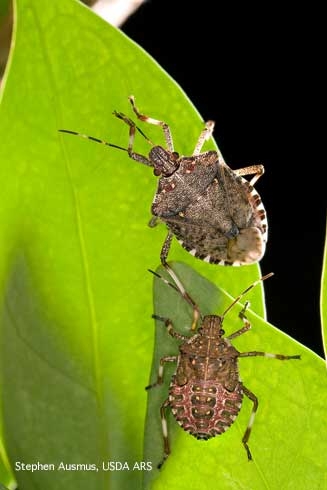Stink bugs are common pests in gardens but the brown marmorated stink bug, or BMSB, is of particular concern. BMSB (Halyomorpha halys) was first detected in Los Angeles County in 2006 and has since been detected in many other parts of California with large populations in some counties.
What does BMSB look like?

(Credit: S Ausmus)
- Two white bands on the antennae
- Forward edge of head is blunt
- Margin of the shoulder is smooth
- Legs are marbled brown with faint white bands
- Membranous parts of forewings have dark bands at the tip
- Banded abdominal edge is visible to the side of the wings
What damage does BMSB cause?
BMSB can feed on more than 100 host plants including tree fruit, vegetables, shade trees, and leguminous crops. They also feed on ornamental trees and shrubs including tree-of-heaven (an invasive plant in CA), Catalpa, Southern magnolia, redbud, and Chinese pistache. Where BMSB establishes, it can cause severe crop loss, garden loss, and can become a nuisance to people. The insects swarm into homes and other buildings in late fall to find hiding places to spend the winter.
What can you do?
Report BMSB to your local county agricultural commissioner or local UC Cooperative Extension office. You can learn more about BMSB and its damage in our Pest Notes: Brown Marmorated Stink Bug.